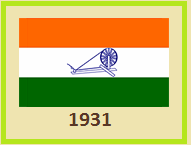If a soldier riding a horse went waving a white flag towards his enemy on a battlefield, lots of people drop their weapons and begin to relax (unless it’s a video game with whacky rules). That’s a soldier telling the enemy that they want peace.
If a ship with a flag bearing skull & bones came towards you, you would roll your fists and get ready for a nice long fight (especially if you have a big treasure chest full of gold coins next to you). That’s a pirate ship approaching you.
A small piece of cloth tells a thousand stories. Such is the power of a flag. Whether it is the skull & bones of a pirate or the white flag of peace in the middle of war, one look at the flag, and you’ll know what story is likely to follow.
This edition of the ‘Lighter Side’ should be reaching you on Jan 26th (India’s Republic Day). Whether you are one of those that likes to watch the parade on TV or someone who takes the opportunity to curl up and sleep longer (residents of India get a holiday), you’ll find this picture of India’s Republic Day parade, an absolute delight!
The tricolour flag fluttering along the entire pathway is unmissable. But how did India get its flag? Did it always look like this? We’ll trace the journey through 3 short stories.
The first flag had loads of drawings with plenty of colours
In 1907, a lady clad in a saree traveled from Paris to Germany. Madame Cama was there to attend a conference. When the organiser suggested that they hoist a flag to represent India’s participation in the conference, someone brought the Union Jack to him. This was Britain’s flag and Britain controlled India. Madame Cama would have none of this. She stepped forward and opened her handbag. She took out a silk cloth that had the Indian flag printed on it. She and a couple of her friends (incl. Veer Savarkar) had designed this flag.
Vande Mataram was written in the Hindi script in the centre. It had the sun and a crescent moon - symbolising multiple religions. The words ‘Vande Mataram’ in the middle was India’s ralling war cry against British rule.
Along came a flag that Gandhiji was fond of
By the 1920s, Gandhiji was the man leading India’s Congress. He was beginning to notice that more and more Indians did not like the sight of the British flag on their buildings. Freedom fighters were asking for a flag that represented India. A teacher cum geologist cum linguist (Pingali Venkaiyya) was the man chosen for this. He had published a book with 16 flag ideas (he obviously loved drawing!). Gandhiji liked one of them. This became the Indian flag for a little while (1931 till 1947).
Trivia Time: The flag that Pingali Venkayya showed Gandhiji had only two colours - red and green - representing Hindusim and Islam. Gandhiji suggested that he add white to represent people of all other religions.
The tricolour we know came along in 1947
The British were packing their bags and getting ready to leave India. Naturally Indians were thrilled. They were waiting to celebrate the moment of India’s independence with great fanfare. What flag was India going to choose as a new and independent country? Most people had grown used to the tricolours of saffron, white and green. But Congress leaders felt that the Ashok Chakra embodied the spirit of the new India better. The 24 spokes on the wheel showed time on a clock and that India was going to progress as time went by. The charkha was replaced by the wheel (Ashok chakra) in the centre. That’s India’s flag to this day!
On a different note, do you love reading books?
I am doing a book review of the book ‘Wonder’ on the 2nd of March (Saturday). I’d love children to join me on a video-call and chat about what they loved about the story. I will also be sending the book-geeks one short exercise every week (like sharing a quick audio note about your fav chapter OR a sketch of a scene from the story). This will help us all get our thoughts together on the book, before we do the book review.
Would you like to be a part of this? If so, please do sign up here. It’s FREE and I hope to see you there on March 2nd!





